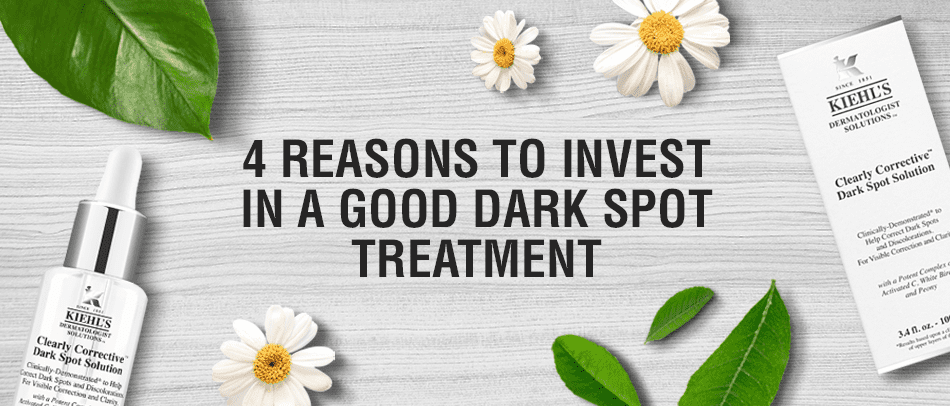Dark spots are a skin issue that can be infuriating to deal with, especially the pesky spots that keep coming back. After spending weeks or even months trying to lighten those spots, there’s still a probability that they may return in a month or so!
Anyone would agree that the best way to deal with an issue is to address it at its source. Similarly, the key to permanently removing dark spots is to understand what lead to them in the first place.
If you struggle with recurring or stubborn dark spots, read on to learn what causes them and how brightening treatments work can help you get rid of them for good.
What causes dark facial spots?
Hyperpigmentation happens when the skin generates too much melanin, resulting in dark patches on the face. Many factors are behind this, but the most common include age, sun exposure, scarring, and inflammation.
- Aging
Flat brown, gray, or black dots on the skin are age spots. Age spots are inherited, so if they run in your family, you’re more likely to have them, too. They may also be exacerbated by UV radiation exposure from tanning beds or the sun. Age spots commonly appear on the back of the hands and face, which are body parts most exposed to the sun.
- Sun exposure
Sunlight triggers the formation of melanin or the natural component that gives your skin color and protects it from damaging rays. Excessive sun exposure may trigger an overproduction of melanin, resulting in hyperpigmentation. Skin that has been uniformly browned will begin to look mottled and reveal concentrated dark areas.
- Acne, wounds, and cuts
Post-inflammatory hyperpigmentation (PIH) may occur due to pimples, cuts, wounds, and other abrasions on the skin. As they recover, they form scars that appear dark due to swollen skin tissues that contain too much melanin. PIH is tough to get rid of completely, and although it often diminishes with time, it can also become permanent since they are technically scars.
- Irritation from products
Harsh cosmetics and skincare products may irritate the skin, which leads to PIH. This is why mild products are recommended for people who struggle with hyperpigmentation. They’re less likely to irritate your face, thus not worsen your dark spots. Additionally, new dark spots will cease forming once your skin is no longer inflamed, helping you achieve flawless skin over time.
How do brightening treatments work?
Many individuals turn to natural or home treatments to get rid of discoloration and dark spots. However, these may irritate the skin even more. For example, the American Society for Dermatological Surgery (ASDS) discourages the use of lemon juice and abrasive scrubs for brightening because they can aggravate dark spots.
Rather than opting for DIY treatment, using a dermatologist-tested dark spot treatment will help you get more remarkable results. Most brightening treatments act by lowering the amount of melanin in the skin. Brightening compounds, the most common being vitamin C, are often found in these products. The substance inhibits the enzyme tyrosinase, which is needed for melanin formation.
Kojic acid, arbutin, licorice extract, and azelaic acid are all typical ingredients of dark spot correctors and have the same effect.
Benefits of using a dark spot treatment
- Lighten post-acne marks and dark spots caused by sun exposure
Dark spot treatments with vitamin C or retinol can prevent excessive melanin formation and protect against premature skin aging due to UV damage.
- Even out hyperpigmentation
The most obvious benefit of a dark spot treatment is fading hyperpigmentation, which reveals a more even complexion. Activated C, for instance, is a quick-acting type of vitamin C that lessens the severity and look of existing discoloration. It immediately enters the skin to help balance its tone and promote clarity.
- Works even on darker skin tones
The American Academy of Dermatology (AAD) recommends 2% hydroquinone, azelaic acid, glycolic acid, retinoids, and vitamin C, to name a few, for dark spots on skins of color. This way, it will keep its natural tone.
- Prevent dark spots in the future
Within 6 to 12 months, an area darker than your normal skin tone will lighten to its natural color. However, if the discoloration is deeply embedded, it may take years for it to fade. Nonetheless, the process of repairing dark spots is gradual but effective—even preventing dark spots in the future.
Bid dark spots bye-bye
Like any other skin problem, the key to managing dark spots is to figure out what works best for your skin type. To hasten skin healing, it’s best to get a skin consultation to make sure you’re using the right kind of products.
If you’re looking for a dark spot treatment that suits sensitive skin, check out Kiehl’s Clearly Corrective Dark Spot Solution. It suits a wide range of skin types because it has no silicones, parabens, scent, colorants, or optical diffusers.
Get a free skin consultation regarding various skin concerns by contacting Kiehl’s on Facebook.

